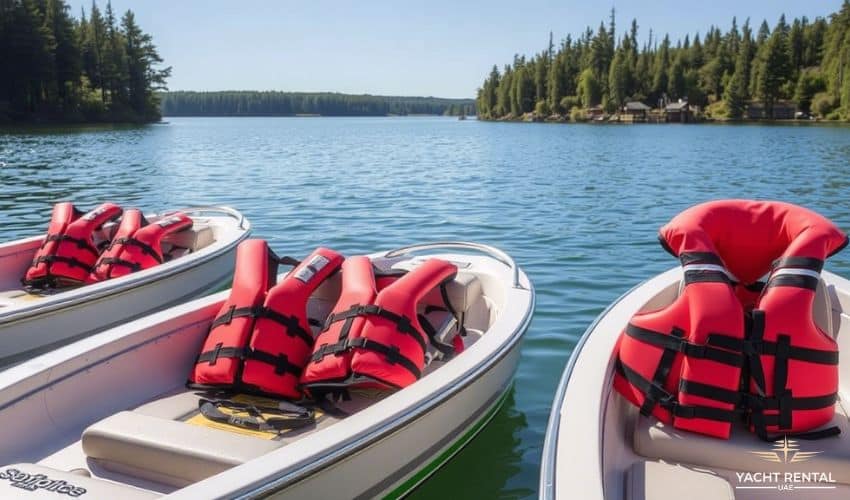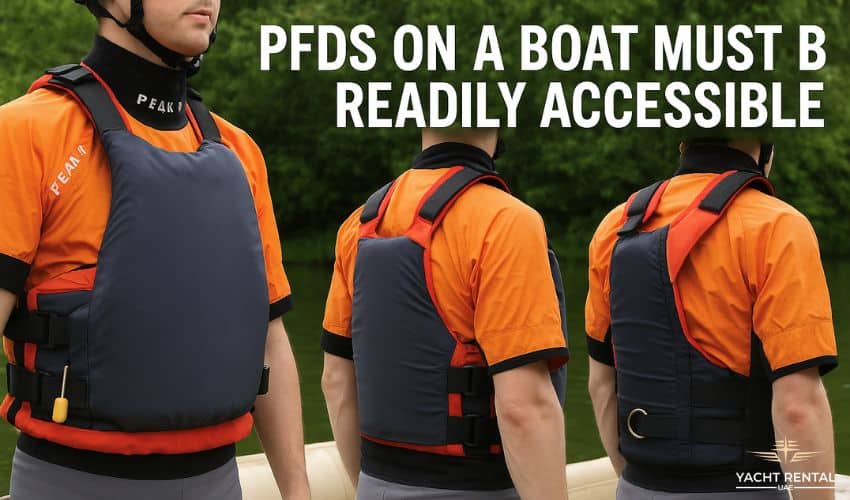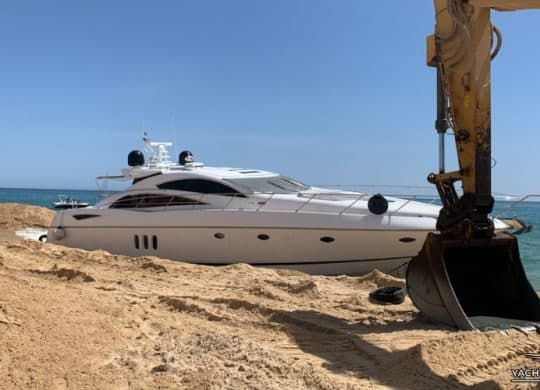Understanding “Readily Accessible” PFD Storage
Boating authorities like the U.S. Coast Guard (USCG) define “readily accessible” with specific criteria. It means PFDs must be quickly reachable without delay in an emergency situation. Passengers need the ability to grab a PFD fast if someone falls overboard or the vessel faces trouble.
Storage locations requiring tools, unlocking, or moving heavy items do not meet this standard. PFDs buried under gear in a locker or still sealed in their original plastic bags also fail the accessibility test. The core principle is immediate availability for rapid donning when seconds count.
The Importance of Accessible PFDs
Having PFDs readily accessible directly impacts boat safety and adherence to regulations. Drowning ranks as a leading cause of boating fatalities, and immediate access to a PFD significantly boosts survival chances during capsizing or man-overboard events. Proper storage ensures these life-saving devices serve their intended purpose effectively.
From a legal perspective, neglecting the readily accessible requirement can lead to significant fines or even criminal charges, varying by jurisdiction. Maritime authorities enforce this rule strictly because inaccessible PFDs undermine safety protocols and endanger lives.
Optimal Storage Methods for PFD Accessibility
Selecting the right storage method is key to ensuring PFDs are always ready and accessible. Various effective options exist, depending on the boat’s layout and size. Each approach balances accessibility with organization and protection of the devices.
Read: Which Type of Boat Must Have a Capacity Plate
Dedicated PFD Storage Areas
Creating a dedicated storage area, like specially designed lockers, is a highly effective strategy. Often located near the helm or in the cockpit area, these spaces keep PFDs organized and protected. Clear labeling makes these areas easily identifiable for passengers needing a PFD quickly.
Proper ventilation within these lockers is important to prevent mildew and maintain the PFDs in good condition. Owners should avoid using these dedicated spaces for storing other gear, such as dock lines, which could obstruct access. Such solutions promote safety awareness among everyone on board.
Designated Open Storage Areas
Using an open area on the boat, such as the cockpit or a clear space on the deck, provides high visibility. This storage method allows for very quick retrieval and distribution of PFDs during an emergency. Keeping PFDs in the open also helps prevent moisture buildup and potential mildew.
However, passengers must ensure these open areas remain clear, and the PFDs are secured against being washed overboard in rough conditions. While simple, this approach requires discipline to keep the designated space unobstructed. Brightly colored PFDs or those with reflective tape enhance visibility in these open setups.
Under-Seat or Floor Storage
Utilizing space under seats or flooring can be practical, especially on smaller vessels with limited room. Many boats feature built-in compartments or open areas beneath seating suitable for PFD storage. This method keeps PFDs out of the way yet potentially within easy reach.
Access must remain completely unobstructed for this method to be considered readily accessible. Storing other items alongside the PFDs could impede quick retrieval and should be avoided. Clear labeling or visual cues are essential so passengers can locate the PFDs without hesitation.
Hooks, Racks, and Shelves
Installing wall-mounted hooks, racks, or open shelves offers another accessible storage solution. Placing these near the cockpit, along cabin walls, or in other high-traffic areas keeps PFDs visible and easy to grab. These fixtures must securely hold the PFDs, especially in rough waters.
Open shelves should ideally be at eye level for easy spotting. Built-in PFD racks are sometimes found on specific boat types, providing a tailored storage solution. This method avoids placing PFDs in closed compartments or distant locations.
Storage Bags and Nets
Specialized PFD storage bags, often made of mesh for ventilation, are popular choices. These bags can be hung in visible spots or secured in convenient locations. Marine nets, particularly useful underneath T-tops and hardtops on the top deck, offer another excellent way to keep PFDs accessible and organized.
Clear carry bags or boat kits can also function well, provided they are easy to open quickly. The location must still allow passengers immediate access. Using storage bags helps protect PFDs while keeping them readily available.
Also Read: What is the First Action Required of a Boat Operator who is Involved in a Boating Accident
Storage Practices to Avoid

Certain storage practices directly contradict the “readily accessible” requirement and must be avoided. Storing PFDs in locked compartments is unacceptable, as access is delayed. Similarly, placing them under heavy gear or equipment renders them inaccessible during an emergency.
Keeping PFDs sealed in their original plastic bags prevents immediate use and does not meet regulations. Storing PFDs mixed with other items like dock lines or waste in a locker can obstruct quick retrieval. Any method that hinders immediate access compromises safety and fails legal compliance.
Tailoring Storage to Different Boat Types
The ideal PFD storage method often depends on the specific type of boat. Space constraints and layout vary significantly across different vessels. Adapting the storage strategy ensures optimal accessibility regardless of the boat’s design.
Ski Boats and Towboats: These boats typically have limited storage space, making under-seat storage or designated open areas near the observer’s seat common choices. Easy access is critical for skiers and tubers. Some models incorporate built-in PFD racks.
Pontoon Boats: Their spacious decks offer flexibility; dedicated lockers or large storage bags placed near railings or under seats work well. Using flotation cushions that double as throwable PFDs is also practical. The goal is convenient placement around the large open space.
Cabin Cruisers and Larger Boats: More storage space allows for dedicated PFD lockers near the main deck or cabin entrance. Open racks or shelves in high-traffic zones are also effective. Distributing PFDs in multiple accessible locations might be necessary on very large vessels.
Sailboats: Limited space poses a challenge, often addressed with compact, portable PFD bags secured in the cockpit area or near the companionway. Built-in compartments or hanging racks are sometimes utilized. Cockpit lockers or storage seating are popular spots, prioritizing the top deck or easily reached areas.
Maintaining PFDs in Storage

Proper storage not only ensures accessibility but also helps maintain the PFDs in good, serviceable condition. PFDs should be dried thoroughly before storing to prevent mold or mildew, especially after exposure to salt water, which requires rinsing with fresh water. Avoid using harsh chemicals for cleaning.
Experts recommend air-drying, especially in well-ventilated areas, as UV exposure can fade and degrade the material over time. Store PFDs loosely, avoiding tight compression or placing heavy objects on top, which can damage the flotation material and compromise effectiveness. Regular inspection for rips, tears, broken straps, or other damage is crucial; damaged PFDs must be replaced.
Legal Requirements and Proper PFD Selection
Beyond accessibility, several legal requirements govern PFDs on boats. All PFDs must carry U.S. Coast Guard (USCG) approval. Vessels must carry at least one wearable PFD of the correct size for each person on board.
Ensuring each PFD is in good, serviceable condition is another legal mandate. Certain boat sizes and types also require a throwable device (Type IV PFD). When selecting a PFD for a passenger, the most critical factor is achieving a snug and comfortable fit; an improperly sized PFD may not function correctly.
Final Considerations for PFD Accessibility
Prioritizing readily accessible PFD storage is fundamental to responsible boating and maximizing passenger safety. Utilizing methods like open compartments, designated bags or lockers, under-seat storage (if unobstructed), or hooks and racks facilitates the necessary quick retrieval in emergencies. Always avoid storage locations that are locked, blocked, or require unpacking.
Remember that PFD maintenance, ensuring good condition, and selecting the correct size and fit are equally vital components of boat safety. Adherence to USCG regulations and choosing appropriate storage methods foster a safer environment for everyone on board. Ultimately, the safest approach involves encouraging passengers to wear their PFDs, especially in challenging conditions or during water activities.







